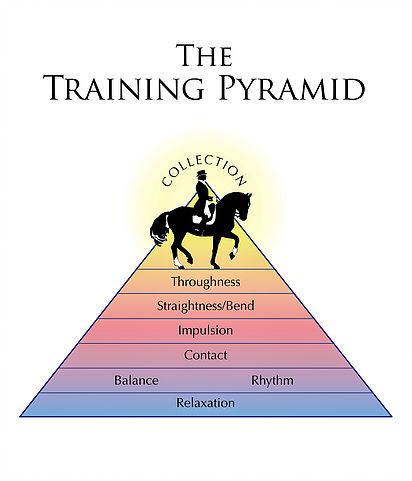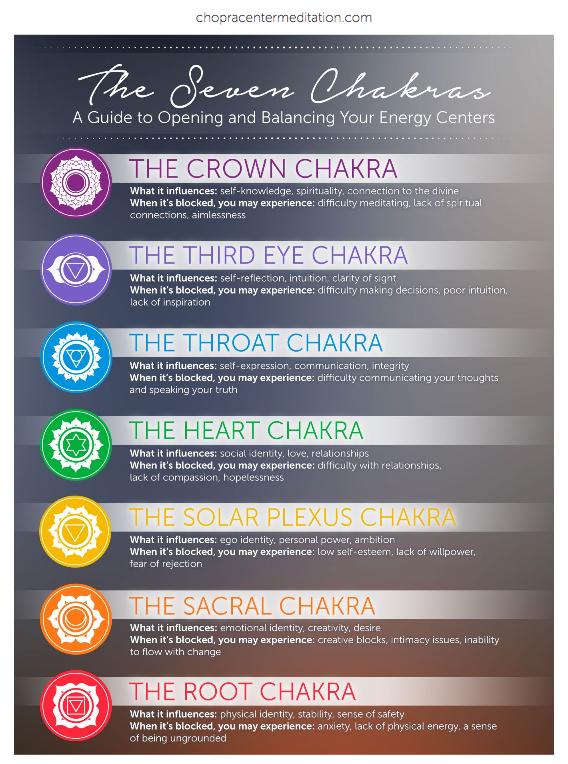
Chakras & the Training Pyramid: Part 1
Relaxation and the root chakra.
Riding, at its absolute best, is part sport and part art. The sport part includes all the technical training (of both horse and rider), and footing and tack fit and all of the physical elements.
The art part is much more challenging to define, because art in general is so personal – what one person considers beautiful, another may not appreciate in quite the same way. Too, the artistic aspects of riding (or driving) can seem so intangible as to be somewhat on the “woo woo” side of the brain. (Query to self: maybe some positive vibe crystals in the barn could be a good thing?)
There are several variations of the classic training pyramid, at least one of which includes seven levels: Relaxation, Balance and Rhythm, Contact, Impulsion, Straightness and Bend, Throughness, and Collection.

This illustration first appeared in the November 1997 issue of Dressage Today magazine (DressageToday.com). Used here with permission.
And here’s an interesting fact to consider: so does the chakra system. The seven chakras come from the spiritual traditions of the East. According to these traditions, the chakras, or life-forces, combine to form the basis of existence, including one’s psychological, physical, energetic, and spiritual being.
Starting from the base and moving upward, the chakras include:
First chakra: the root chakra. Located at the base of the spine within the pelvic bowl, the root chakra represents the base elements of physical existence, including one’s need for safety, food, and regeneration. This chakra is thought to connect one to the earth.
Second chakra: the sacral chakra. Located just below one’s navel, the sacral chakra represents one’s creativity and emotions.
Third chakra: the solar plexus chakra. Located in the mid-abdominal area in the stomach region, the solar plexus chakra represents one’s mental abilities and personal will.
Fourth chakra: the heart chakra. Located at the heart level of the chest, the heart chakra represents compassion, love, and all things beautiful.
Fifth chakra: the throat chakra. Located, as one might expect, at the throat, this chakra represents communication.
Sixth chakra: the third eye chakra. Located between the eyebrows, the third eye chakra represents one’s intuition.
Seventh chakra: the crown chakra. Located at the top of one’s head, the crown chakra represents one’s connection to the universe.
Why would one want to try and find correlations between these two seemingly very diverse things? Because both deal with energy, and understanding any correlations between horse and human will make us better riders!
So, let’s explore, shall we? (And if you’re a fan of the six-tier training pyramid, that’s cool. Go with me here for the next few weeks and see how that version of the pyramid still fits with the chakra system.)
The horse’s training begins with relaxation. Why? Because a tense mind and body does not process new information well. A horse needs to feel safe first and foremost, in order to free its mind to focus on learning. Once he feels safe, he can relax and listen to what his rider/driver/trainer is asking him to do. From a physiological perspective, a tense mind and body cannot create positive muscle memory – from leading quietly as a weanling to canter pirouettes as a Grand Prix elite. Relaxation is the foundation of successful learning for a horse.
Similarly, relaxation is the foundation of safe and successful human interaction with horses, from the ground, in the saddle, or from the buggy seat. And the first chakra, the “base” chakra, relates to survival and passions and feeling safe, especially with respect to our basic needs – food, water, shelter, and companionship. Associated with the color red, the base chakra is located in the pelvic bowl of humans.
And surprise (not), what’s the very first thing a great rider aspires to achieve? A great seat.
So! Releasing any tension in your pelvic bowl, opens (aligns) that chakra and – bonus – transmits that relaxed feeling directly to your horse.
How does one open the pelvic bowl? Deep breathing. As in, ignore your lungs and your diaphragm and go lower. Imagine there’s an inflatable ball about the size of a basketball sitting inside your belly, between the pelvic bones. This imaginary ball has two exhaust pipes exiting the bottom portion of the ball, each exhaust pipe aligning perfectly with your right or left hip joint.
As you inhale, focus on inflating that ball, slowly and completely. You’ll know you’re doing this correctly if your shoulders don’t raise up as you take air in. Also, don’t focus on distending your belly with your air intake. You want to feel like you’re inflating that ball in your pelvic region.
As you exhale, focus on moving the air out through those imaginary exhaust pipes. In this mental game, the exhaled air should, in your mind, travel down each hip joint and on down the leg, to exit out your heels. This allows you to relax your entire seat and both legs all the way around your horse.
If you want to think of words or a phrase to go along with this deep breathing exercise, such phrases as, “we are safe,” or “all is well” can help keep your mind in a state of calm and relaxation.
Ideally, as your breathing literally cleanses your body (intake of oxygen; expulsion of carbon dioxide), your heartrate slows just a bit, your muscles relax, and the physiological message you send to your horse is very clear: I am relaxed, so you, too, can be relaxed. All is well.
And so a symbiotic communication begins between human and horse. The human’s body, via the deep breathing, is communicating, “I’m relaxed and all is well.” The horse’s body receives this communication and responds, “okay, I’ll relax more and focus on you.”
“I’m relaxed and all is well.” “Okay, I’ll relax more and focus on you.”
Repeat. Repeat. Repeat. Every breath. Every stride.
Another bonus of this interconnectedness between relaxation of the human and relaxation of the horse is this: the rider can control those mental exhaust pipes, both with respect to direction and volume of flow.
So, for example, if you want to bend your horse around your left leg, mentally imagine opening the left exhaust pipe’s valve a bit wider than the right valve. This will automatically cause your body to drop your left seat bone just a tad deeper into the saddle, and give a little more weight to your left leg, which will help the horse bend around that leg.
Next week: rhythm and the sacral chakra.








Leave a Comment